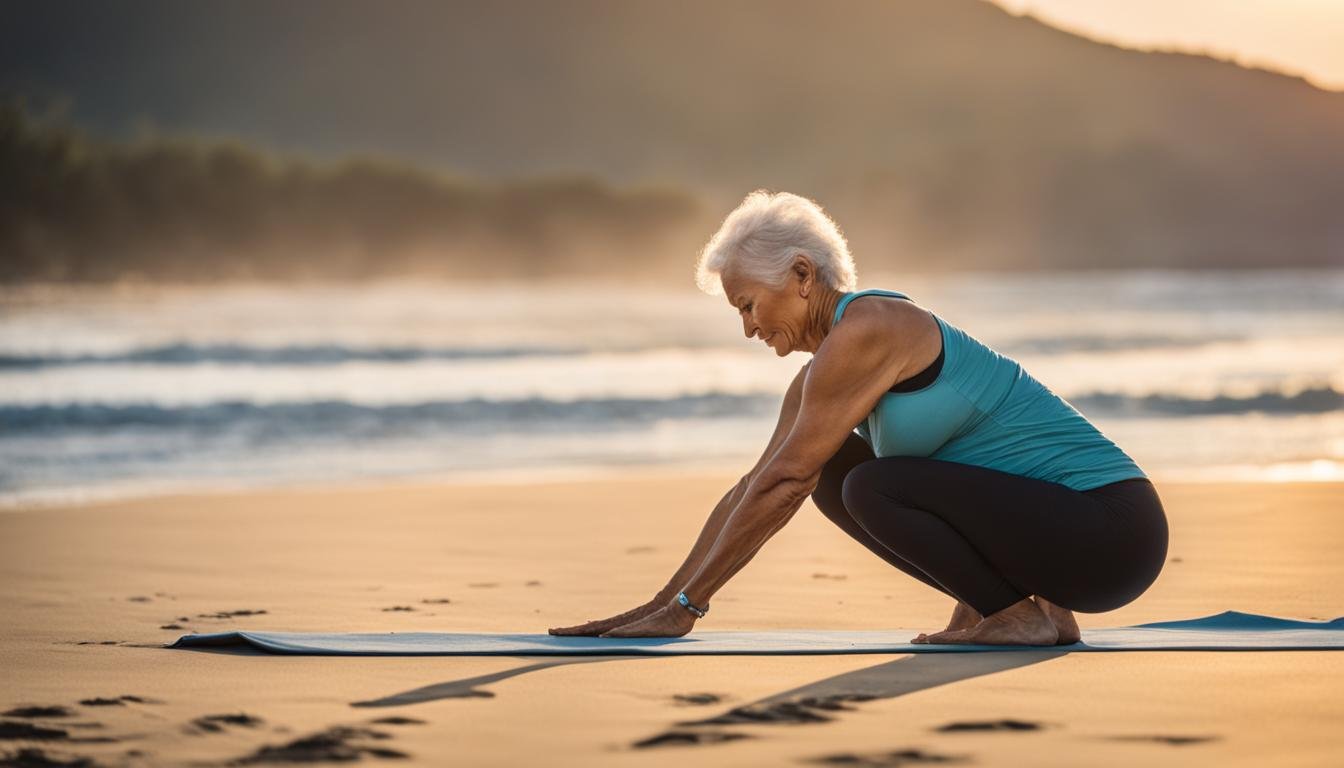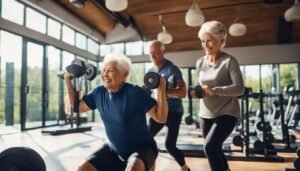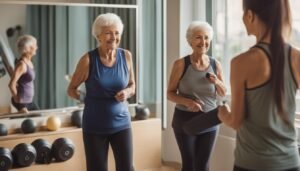When it comes to physical fitness, “aging gracefully” doesn’t mean you have to give up on staying active. Research suggests that exercise can protect against numerous chronic conditions and have a positive impact on cardiovascular health, bone strength, brain health, and emotional well-being. As we age, our fitness needs change, and it’s important to adapt our workout routines to address age-related concerns. In this article, we will explore age-adapted exercise plans that can help you maintain fitness at any stage of life.
Key Takeaways:
- Senior fitness programs can provide personalized fitness routines tailored to various ages.
- Exercise plans for older adults should be designed specifically for their age group.
- Customized exercises for seniors can target the specific needs and abilities of aging individuals.
- Specialized fitness plans for seniors can help address age-related concerns and maintain overall well-being.
- Fitness regimens for different age groups should incorporate targeted workouts that cater to the unique needs of each stage of life.
The Benefits of Exercise for Older Adults
Exercise offers numerous benefits for older adults, promoting both physical and mental well-being. Regular physical activity has been shown to reduce the risk of cardiovascular disease, stroke, and diabetes. It can also help prevent certain types of cancer and maintain a healthy weight. By engaging in balance exercises, older adults can improve their stability and reduce the risk of falls. These exercises, such as standing on one leg or walking heel-to-toe, help strengthen the muscles and improve coordination.
Osteoporosis, a common condition among older adults, can be managed through exercise. Weight-bearing exercises, such as brisk walking or dancing, help to stimulate bone growth and maintain bone density. In addition to the physical benefits, exercise has a positive impact on brain health. Studies have shown that regular physical activity can improve cognitive function and reduce the risk of cognitive decline in older adults. Additionally, exercise has been linked to improved emotional well-being, reducing the risk of depression and promoting a sense of social connectedness.
Exercise offers numerous benefits for older adults, including protecting against chronic conditions, improving bone strength and brain health, and promoting emotional well-being.
Incorporating exercise into daily routines is essential for older adults to maintain their overall health and vitality. Whether it’s through activities like walking, swimming, or yoga, staying active can greatly enhance the quality of life in older adults. It is important to consult with a healthcare professional before starting any exercise program to ensure safety and suitability for individual needs. By making exercise a priority, older adults can reap the numerous benefits and enjoy a healthier and happier life.
The Benefits of Exercise for Older Adults:
- Reduces the risk of cardiovascular disease, stroke, and diabetes
- Helps prevent certain types of cancer
- Improves balance and reduces the risk of falls
- Manages osteoporosis and maintains bone density
- Enhances brain health and cognitive function
- Promotes emotional well-being and reduces the risk of depression
| Benefit | Exercise |
|---|---|
| Cardiovascular Health | Brisk walking, cycling, swimming |
| Bone Health | Weight-bearing exercises: walking, dancing |
| Balance and Coordination | Balance exercises: standing on one leg, heel-to-toe walking |
| Brain Health | Aerobic exercises, such as jogging or dancing |
| Emotional Well-being | Any enjoyable physical activity |
How Fitness Needs Change as We Age
As we age, our fitness needs change. It is important to adapt our exercise routines to address these changing needs and maintain our overall fitness and well-being. The Centers for Disease Control and Prevention recommends that adults of all ages get at least 150 minutes of moderate-intensity exercise each week. However, the types of exercises and focus may shift as we get older.
Strength Exercises
Strength exercises become even more important as we age. Building and maintaining muscle mass can help support joint health, improve balance, and prevent age-related muscle loss. Incorporating weightlifting, resistance band exercises, or using weight machines can help strengthen muscles and bones.
Endurance Exercises
Endurance exercises, such as walking, swimming, or cycling, are crucial for maintaining cardiovascular health. Regular aerobic activities help improve heart and lung function, increase stamina, and lower the risk of chronic diseases. Aim for at least 30 minutes of moderate-intensity aerobic exercise most days of the week.
Balance Exercises
Balance exercises become more important as we age to prevent falls and maintain stability. Incorporating activities like yoga, tai chi, or standing on one leg can help improve balance and coordination. Include balance exercises at least two to three times a week.
Flexibility Exercises
Flexibility exercises are essential for maintaining joint flexibility and mobility. Stretching exercises, yoga, or Pilates can help increase flexibility, prevent muscle stiffness, and improve posture. Aim for at least two to three stretching sessions per week.
| Exercise Type | Frequency | Duration |
|---|---|---|
| Strength Exercises | 2-3 times per week | 15-20 minutes per session |
| Endurance Exercises | 5 times per week | 30 minutes per session |
| Balance Exercises | 2-3 times per week | 10-15 minutes per session |
| Flexibility Exercises | 2-3 times per week | 10-15 minutes per session |
By incorporating a mix of strength, endurance, balance, and flexibility exercises into our fitness routines, we can address the changing needs of our bodies as we age. It is important to listen to our bodies, start gradually, and consult with a healthcare professional or certified fitness trainer to ensure we are engaging in exercises that are safe and appropriate for our fitness levels.
Modifications for Age-Related Concerns
As we age, it’s important to make modifications to our exercise routines to address age-related concerns. Here are some tips and modifications for common issues that may arise:
Exercise during Menopause
During menopause, hormonal changes can lead to symptoms such as hot flashes, mood swings, and weight gain. Engaging in regular physical activity can help alleviate these symptoms. It’s important to choose exercises that you enjoy and that don’t exacerbate your symptoms. Consider activities like walking, swimming, or yoga, which can help improve mood and maintain a healthy weight.
Exercising with Arthritis
If you have arthritis, it’s essential to choose exercises that are gentle on your joints. Low-impact activities like swimming, cycling, or using an elliptical machine can help reduce joint pain and stiffness. Avoid high-impact exercises that put excessive stress on your joints. Listen to your body and modify your workout intensity and range of motion as needed.
Exercise for Osteoporosis
For individuals with osteoporosis, weight-bearing exercises are recommended to strengthen bones and reduce the risk of fractures. Activities like walking, dancing, or stair climbing can be beneficial. It’s important to work with a healthcare professional or a certified trainer to ensure proper form and technique to minimize the risk of injury.
Exercise for Increased Fatigue
If you’re experiencing increased fatigue, it’s essential to listen to your body and pace yourself. Start with shorter, more manageable workouts and gradually increase the duration and intensity as you build stamina. Focus on activities that enhance strength and endurance, such as resistance training or low-impact aerobic exercises. Don’t forget to prioritize rest and recovery to avoid overexertion.
Exercise with Limited Mobility
For individuals with limited mobility, there are still plenty of exercise options available. Chair exercises, gentle yoga, or water aerobics can provide a safe and effective way to stay active. Using supports such as chairs or props can help improve balance and stability. Consult with a healthcare professional or a qualified trainer to create a personalized exercise plan that suits your abilities and goals.
Safety Precautions
Regardless of age or ability, safety should always be a priority when exercising. It’s crucial to warm up properly before each workout and cool down afterward. Pay attention to your body’s limitations and avoid pushing yourself beyond your comfort zone. Use appropriate equipment and gear, such as supportive shoes and protective padding, when necessary. If you have any existing medical conditions or concerns, consult with your healthcare provider before starting a new exercise program.
| Age-Related Concerns | Tips/Modifications |
|---|---|
| Menopause | Choose activities that alleviate symptoms, such as walking, swimming, or yoga. |
| Arthritis | Opt for low-impact exercises like swimming or cycling to reduce joint pain. |
| Osteoporosis | Incorporate weight-bearing exercises like walking or dancing to strengthen bones. |
| Increased Fatigue | Start with shorter workouts and focus on strength and endurance activities. |
| Limited Mobility | Engage in chair exercises, gentle yoga, or water aerobics for safe and effective workouts. |
| Safety Precautions | Warm up and cool down properly, use appropriate equipment, and consult with a healthcare professional. |
Reducing Injury Risk and Exercising with Joint Pain
When it comes to exercise, reducing the risk of injury is crucial, especially as we age. Incorporating specific strategies can help protect our joints and minimize the potential for harm. Here are some tips to reduce injury risk and exercise safely, even with joint pain:
- Start low and go slow: Begin with low-impact activities, such as walking or swimming, and gradually increase the intensity and duration of your workouts over time.
- Choose joint-friendly activities: Opt for exercises that are gentle on the joints, such as cycling, elliptical training, or water aerobics. These activities provide cardiovascular benefits without placing excessive stress on the joints.
- Modify activity when symptoms increase: Pay close attention to your body’s signals. If you experience increased joint pain or discomfort during exercise, modify the activity or try alternative exercises that are less demanding on the joints.
In addition to these strategies, it’s essential to listen to your body and adjust your exercise routine accordingly. If you have chronic joint pain or a medical condition, it’s always a good idea to consult with a healthcare professional or a physical therapist before starting or modifying an exercise program.
“By incorporating joint-friendly activities and being mindful of our body’s signals, we can stay active and reduce the risk of injury, even with joint pain.” – Dr. Samantha Johnson, Physical Therapist
Remember, the goal is to stay active while protecting our joints and minimizing the risk of injury. By following these guidelines, you can maintain a safe and effective exercise routine that supports your overall health and well-being. Keep in mind that everyone’s needs and limitations are unique, so be sure to tailor your routine to suit your individual circumstances.
Exercising When You Feel Tired
Feeling tired can make it challenging to find the motivation to exercise, but it’s important to remain active for overall health and well-being. Short workouts can be a great solution when you’re feeling tired. Starting with a 15-minute easy walk or a quick yoga routine can help you get moving without overwhelming yourself. Gradually increasing the duration over time can help manage fatigue and build stamina.
Stretching is another beneficial activity when you’re feeling tired. Incorporating stretching at the beginning and end of each workout session can help improve energy levels and relieve muscle tension. It’s a gentle way to warm up your body and prepare it for physical activity. Focus on stretching major muscle groups such as your calves, hamstrings, quads, and shoulders.
“Exercise when you’re tired actually helps to energize you. It gets your blood pumping and releases endorphins, which can boost your mood and increase alertness.” – Dr. Sarah Johnson, Exercise Physiologist
Resistance training can also be effective for combating tiredness. Starting slow with resistance bands or light hand weights can help build strength without causing excessive fatigue. Incorporating low-impact bodyweight exercises, such as gentle yoga or Pilates, can also be beneficial. These exercises engage multiple muscle groups and improve flexibility while being easier on the joints.
| Exercise Type | Benefits |
|---|---|
| Short workouts | Help manage fatigue, build stamina |
| Stretching | Improve energy levels, relieve muscle tension |
| Resistance training | Build strength without excessive fatigue |
| Low-impact bodyweight exercises | Engage multiple muscle groups, improve flexibility |
Remember, it’s important to listen to your body and not push beyond your limits when exercising while tired. If you’re feeling excessively fatigued or experiencing any unusual symptoms, it’s always a good idea to consult with a healthcare professional before starting or modifying your exercise routine.
Exercising with Mobility Issues
For individuals facing mobility issues, engaging in regular exercise may seem challenging. However, with the right support and modifications, it is possible to stay active and prioritize fitness. One effective strategy is to use supports such as chairs, tables, counters, or yoga props to provide stability and assist with balance during workouts. These supports can help individuals with limited mobility perform exercises safely and comfortably.
Consulting a physical therapist or a personal trainer who specializes in working with individuals with mobility issues can also be beneficial. These professionals can provide guidance on modifying exercises to accommodate specific mobility limitations, ensuring a safe and effective workout routine. They can suggest alternative exercises and equipment that will allow you to engage in physical activity while minimizing the risk of injury.
It’s important to focus on overcoming obstacles and making fitness a priority. While mobility issues may present challenges, it’s essential to maintain a positive mindset and approach exercise as an opportunity for growth and improvement. By setting realistic goals and developing a routine that works for your specific needs, you can make exercise a regular part of your life and reap the many benefits it offers.
Summary: Exercising with mobility issues requires thoughtful modifications and the use of appropriate supports. Consulting a physical therapist or personal trainer can provide valuable guidance and ensure a safe workout routine. By focusing on overcoming obstacles and making fitness a priority, individuals with mobility limitations can lead an active and healthy lifestyle.
| Benefits | Strategies |
|---|---|
| Improved strength and mobility | Using supports such as chairs and tables for stability |
| Reduced risk of falls | Consulting a physical therapist or personal trainer for modified exercises |
| Enhanced overall well-being | Adopting a positive mindset and making fitness a priority |
Exercising During Perimenopause
Perimenopause brings hormonal fluctuations that can impact exercise routines. It’s important to adapt your workouts to manage perimenopause symptoms effectively. Here are some tips to help you stay active and maintain your fitness during this stage of life:
- Raising heart rate with moderate cardio: Engaging in aerobic exercises such as brisk walking, swimming, or cycling for at least 30 minutes a day can help alleviate perimenopause symptoms and improve overall cardiovascular health.
- Managing hot flashes: Hot flashes are a common symptom of perimenopause. To manage them during workouts, make sure to stay hydrated, wear breathable and moisture-wicking clothing, and consider using cold, wet towels or portable fans to cool down when needed.
- Wearing appropriate clothing: Choose workout attire that is comfortable, provides good support, and helps regulate body temperature. Opt for moisture-wicking fabrics that allow your skin to breathe.
- Practicing deep breathing techniques: If a hot flash occurs during exercise, taking a short break to practice deep breathing can help regulate your body temperature and alleviate discomfort.
Remember, listening to your body is key during perimenopause. If you experience any symptoms that significantly impact your ability to exercise comfortably, consult with your healthcare provider for personalized advice and recommendations.
| Exercise Tips During Perimenopause | Benefits |
|---|---|
| Raise heart rate with moderate cardio | Alleviates perimenopause symptoms |
| Manage hot flashes | Reduces discomfort during workouts |
| Wear appropriate clothing | Regulates body temperature and enhances comfort |
| Practice deep breathing techniques | Regulates body temperature and promotes relaxation |
By staying active and adapting your exercise routine to accommodate the changes of perimenopause, you can continue to prioritize your fitness and overall well-being.
Workout Tips By Decade
In order to maintain fitness at any stage of life, it is important to adapt our workout routines to meet the changing needs of our bodies. Here are some workout tips to consider based on the different decades of life:
Exercise in your 20s and 30s
This is the time to establish good exercise habits and focus on building muscle mass and endurance. Incorporate a combination of cardiovascular exercise and strength training into your routine. High-intensity workouts like HIIT (High-Intensity Interval Training) can be effective for burning calories and improving cardiovascular fitness. Don’t forget to also prioritize flexibility and balance exercises to promote overall well-being.
Exercise in your 40s
As we enter our 40s, preserving lean muscle mass becomes a priority. It is recommended to include a balance of high-intensity and lower-intensity workouts in your routine. Incorporate strength training exercises to maintain muscle strength and bone density. Additionally, focus on activities that improve flexibility and joint mobility to prevent stiffness and reduce the risk of injury.
Exercise in your 50s
Weight training becomes crucial during this decade to combat age-related changes in metabolism and muscle mass. Include resistance exercises that target major muscle groups in your routine. Strength training can help maintain muscle mass, increase bone density, and boost metabolism. Don’t forget to add cardiovascular activities for heart health and flexibility exercises to maintain joint mobility.
Exercise in your 60s and beyond
As we age, it is important to choose appropriate workout activities that take into consideration any age-related limitations. Focus on exercises that improve flexibility, balance, and joint stability. Yoga, tai chi, and gentle strength training using resistance bands or light weights can be beneficial. Always listen to your body and make modifications as needed. Prioritize staying active and maintain a consistent exercise routine.
| Decade | Tips |
|---|---|
| 20s and 30s | Establish good exercise habits. Focus on building muscle mass and endurance. Incorporate cardiovascular exercise, strength training, and flexibility exercises. |
| 40s | Preserve lean muscle mass. Include a balance of high-intensity and lower-intensity workouts. Focus on strength training, flexibility exercises, and joint mobility. |
| 50s | Focus on weight training to combat age-related changes. Incorporate resistance exercises, cardiovascular activities, and flexibility exercises for joint mobility. |
| 60s and beyond | Choose appropriate workout activities. Focus on flexibility, balance, and joint stability. Incorporate gentle strength training and low-impact exercises. |
Remember, it’s always important to consult with a healthcare professional before starting any new exercise program, especially if you have any underlying health conditions. By following these workout tips by decade, you can maintain your fitness and lead a healthy lifestyle throughout all stages of life.
Conclusion
Age should never be a barrier to maintaining fitness. With age-adapted exercise plans, individuals can prioritize their health and well-being at any stage of life. By understanding the changing needs of our bodies as we age, we can modify our workout routines to address age-related concerns and continue to reap the benefits of exercise.
Exercise offers a multitude of advantages for older adults, including protecting against chronic conditions, improving bone strength, boosting brain health, and enhancing emotional well-being. By incorporating activities that focus on balance, endurance, strength, and flexibility, we can promote overall health and reduce the risk of falls and injuries.
When it comes to exercise, it’s essential to listen to our bodies and make necessary modifications. Whether it’s adapting workouts during menopause, managing joint pain, exercising when tired, or overcoming mobility issues, there are ways to stay active while considering individual needs and limitations. Consulting healthcare professionals, such as physical therapists or personal trainers, can provide valuable guidance and ensure safety throughout the fitness journey.
Remember, age is just a number, and our commitment to maintaining fitness should transcend the decades. By making exercise a priority, incorporating age-appropriate activities, and staying consistent, we can lead a healthy lifestyle and continue to enjoy the benefits of physical fitness throughout our lives.
FAQ
What are age-adapted exercise plans?
Age-adapted exercise plans are fitness routines that are specifically tailored to address the changing needs and concerns of individuals as they age. These plans take into account factors such as mobility limitations, increased fatigue, and age-related conditions to ensure a safe and effective workout.
What are the benefits of exercise for older adults?
Exercise for older adults can protect against chronic conditions such as cardiovascular disease, stroke, diabetes, and certain forms of cancer. It can also improve bone strength, brain health, and emotional well-being, reducing the risk of depression and promoting social connectedness.
How do fitness needs change as we age?
Fitness needs change as we age, and it’s important to adapt our workout routines accordingly. The focus may shift from high-intensity cardio or body sculpting to exercises that promote overall well-being and disease prevention. This can include strength training, endurance exercises, balance exercises, and flexibility exercises.
What modifications should be made for age-related concerns?
Age-related concerns such as menopause, arthritis, osteoporosis, increased fatigue, and limited mobility may require modifications to exercise routines. It is important to choose exercises that are appropriate for each condition, modify intensity and range of motion as needed, and ensure safety precautions such as proper warm-up and using correct equipment.
How can I reduce the risk of injury and exercise with joint pain?
To reduce the risk of injury, it is important to incorporate stretches, warm-up properly, use machines instead of free weights, and work on balance. For individuals with joint pain, it is crucial to understand the body’s pain cues and avoid movements that cause pain higher than a 5 out of 10. Modifying activity when symptoms increase and choosing joint-friendly activities can help manage joint pain while staying active.
How can I exercise when I feel tired?
Starting with short workouts, such as a 15-minute easy walk, and gradually increasing the duration can help manage fatigue. Incorporating stretching at the beginning and end of each session can also help improve energy levels. It is important to listen to your body and choose exercises that are appropriate for your energy levels, such as resistance training using light weights or low-impact bodyweight exercises.
How can I exercise with mobility issues?
Individuals with mobility issues can use supports such as chairs, tables, counters, or yoga props to help them stay active. Consulting a physical therapist or personal trainer can provide additional guidance and modifications for exercises. It is important to focus on overcoming obstacles and making fitness a priority, giving yourself credit for the effort put into exercise despite mobility limitations.
How can I exercise during perimenopause?
Raising the heart rate with moderate cardio for 30 minutes every day can help alleviate perimenopause symptoms. Managing hot flashes can be done through hydration, appropriate clothing, and using cold, wet towels during workouts. Taking breaks to practice deep breathing and switching to lighter, looser clothing can also help regulate body temperature and prevent discomfort.
What are some workout tips by decade?
In your 20s and 30s, it is important to establish good exercise habits and focus on building muscle mass and endurance. In your 40s, preserving lean mass becomes a priority, and a balance between high-intensity and lower-intensity workouts is recommended. In your 50s, weight training becomes crucial to combat age-related changes in metabolism and muscle mass. In your 60s and beyond, it is important to choose appropriate workout activities, focus on flexibility and balance, and listen to your body while remaining active.






